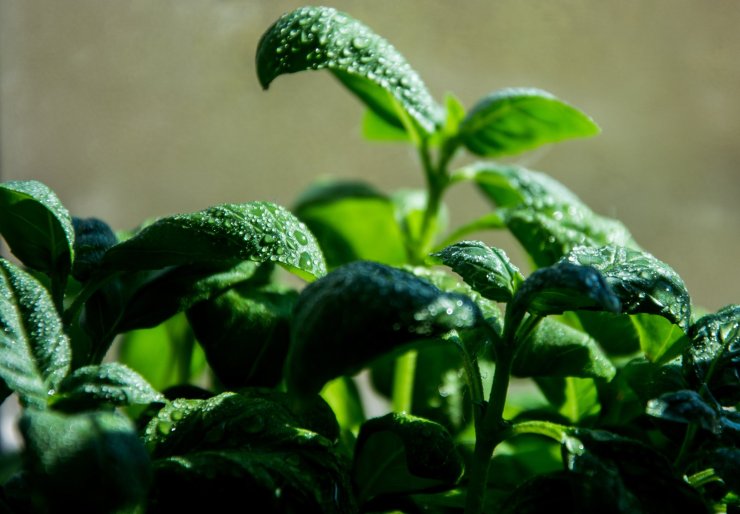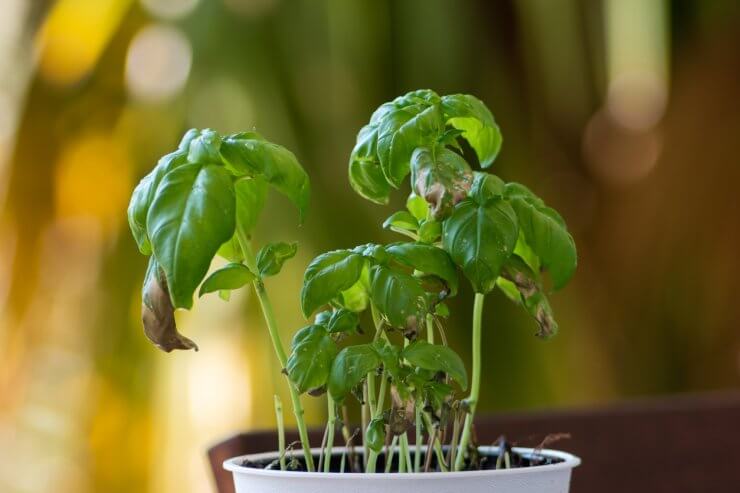
It may not look like an overwatered basil plant. It’s wilty and drab. The leaves look yellow or brown. It certainly looks like it could use a tall drink of water. As a good plant parent, you grab the watering canister and drench the soil. That should do the trick, right? Give it an hour or two, and that basil plant is gonna look great!
Except it doesn’t look great. If anything, it seems worse.
Sound familiar? It’s okay; we’ve all had an overwatered basil plant (or two or three) at some point. It can happen whether your basil is in a pot by itself, in the ground around the tomatoes, or in a window box with other herbs.
For me, it’s always the darn potted basil. Try as I may, I kill basil all the time. I try, try, again, but I can only seem to keep it alive in my hydroponic garden and in my raised beds. So what is it about caged basil in dirt? I decided to find out. Here’s what to look for, and perhaps more importantly, what to do to save your basil.
Find out how easy growing spices and herbs can be—indoors or out! Read our FREEBIE How to Master Spice and Herb Gardening at Home right now!

How to tell if your basil plant is getting too much water
The most accurate way to figure out if you have an overwatered basil plant is by looking at the roots. I don’t know about you, but if I had to dig up every plant every time something seemed off, I’d probably invest in a shovel farm.
Easier to do in a container, more annoying to do in the ground. You may eventually need to dig up your plant to look at the roots, but let’s save that and try some easier approaches first.
Our first line of inquiry here is simply figuring out if our basil has had too much water. And you can’t tell just by looking at the plant, since a wilting basil plant could desperately need water, or it could be woefully overwatered.
So before you panic, think about how much water your basil has received. If it’s in a plastic pot with a tiny drainage hole and you water it twice a day, you may have an overwatered basil plant. On the other hand, if your plant is in the ground and you water it once a week, and it hasn’t rained in forever, that could very well mean your basil needs some water (and your other plants probably do, too).
The second thing you can do is dig your finger into the soil an inch or two. Is it dry? Soggy? Somewhere in between? If your basil is in a pot with a decent-sized drainage hole, can you feel that soil to test how dry or wet it is?
While you’re there, go ahead and look at the stem and roots just above and below the soil. If you notice that either of these are mushy or black, you could very well be dealing with root rot. You can read more about root rot here and here. For now, back to our basil plant.
What to do about that overwatered basil plant before it’s too late
Assuming you haven’t hit the point of root rot and you’ve determined that you do, indeed, have an overwatered basil plant on your hands, here’s what you can do.
Water less frequently. And let the soil dry out between waterings. No great revelation here, I know. You’re like, c’mon Amanda, I’m reading this so you can tell me not to water my plant as much? But wait! There’s more to an overwatered basil plant (or any plant, for that matter) than just the amount of water you’re giving it.
Check your soil. One of my friends has a small garden with about five inches of great soil on top of hard, rocky clay. That top layer of soil drains wonderfully, but once you get to the clay, well, the water doesn’t have anywhere to go. I’ve had similar issues with potted plants when the drainage hole has gotten clogged. The top of the soil dries out, thanks to sunlight and evaporation, and such.
Meanwhile, the bottom half of the soil was pretty much a swamp. Your basil needs well-drained soil, so make sure your soil is well-drained. It’s entirely possible that you could have an overwatered basil plant even without technically overwatering it.
Move things around. If your soil is too wet, whether it’s in the ground or a container, make sure to remove any mulch and aerate the soil around the plant to allow more airflow and to help dry things out.
Prune your plant. Remove any dead and discolored leaves, as well as any stems that seem unhealthy.
Time for a re-pot. If your basil plant is in a container, and things aren’t looking great, it might be time to re-pot it, especially if it’s in a plastic or other non-porous container. Switch to a clay pot or one with better drainage.
Overwatering is much more of an issue than most people realize, myself included. I’ve definitely learned this the hard way. However, once you know what to look for and what to do for one overwatered plant, you can apply that to any plant in your garden!
Have you had to save an overwatered basil plant or other herbs? What steps did you take?
Find out how easy growing spices and herbs can be—indoors or out! Read our FREEBIE How to Master Spice and Herb Gardening at Home right now!





I put 2 small (6-8”) plants in a large (12” diameter and 12” deep) round clay pot just after Mothers Day here in Rhode Island. They grew beautifully and quickly and were lush and green within a month. Stayed that way for another month, and then the leaves started to turn yellow and never grew beyond a skinny 2” yellow leaf. I water daily during intense heat days and every few days most of the time, checking the soil with my finger. I added organic Miracle Grow every 3-4 wks, and pinched flowers regularly. Any thoughts on why the leaves won’t grow big and green anymore?
It sounds like your plants were sending all their energy into producing flowers and that resulted in thinner leaves. A hard prune, not just pinching flowers, may help when this happens.
My basil plant looks like a 5-foot bush and is home to at least 20 bees.
Oh and it’s in my raised bed
I came here because your second picture is excactly my problem. But you don’t say what this means!? Too much water, not enough?
The brown tips quite often means too much water.
YES, Basil had been that ONE herb that I have trouble with. One thing is that it REALLY LIKES to be used. Frequent snipping off the tops of the little branches keeps it growing and seems to keep it form having thoughts of non-survivial. I add it pretty much every meat -vegetable-stir fry-egg dish and the basil LOVES TO BE USED UP.